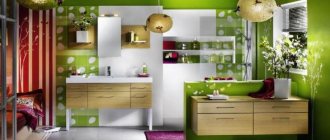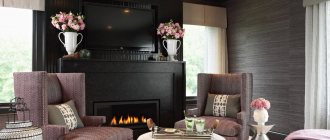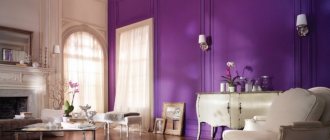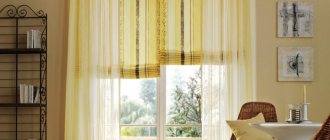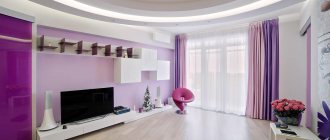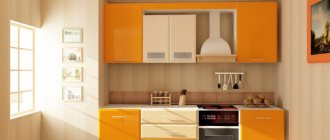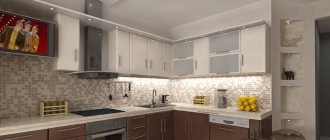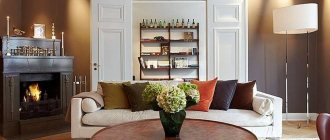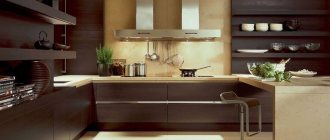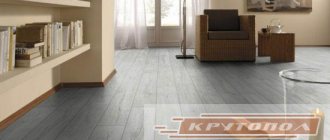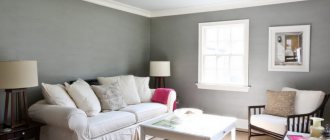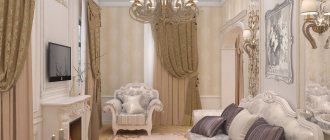Rustic simplicity
Rustic style is incredibly popular. It always conveys an atmosphere of organic beauty, and plum color will only emphasize the uniqueness and stylishness of the interior. Designers are so keen on monochrome interiors that they propose introducing a variety of “delicious” colors into it: chocolate, cherry, peach and blueberry.
Did you like the article? Then support us, click
:
Purple is a complex color; there are no people indifferent to it - either they love it or they don’t. Many people refuse it because they find it too dark, shrouded in myths, and negative connotations. Even those who are very impressed by it are afraid to introduce the color purple into the interior of their home. In vain! The correct use of numerous incredible shades will help to add grace, elegance and style to the design, will give you comfort and amaze the imagination of your guests.
Symbolism and psychology of purple color
“Pheasant” belongs to the group of cool and peaceful tones: it does not smell cold like blue, its neighbor in the rainbow, but it is invigorating and refreshing. In Christianity, purple is a symbol of humility; it is not for nothing that the cardinals’ ring is crowned with a large amethyst.
This color is also a sign of nobility. Its ceremonial colors - amaranth, lilac, hyacinth - can be seen in the royal chambers and residences. Shades of purple, psychologists say, do not excite the nervous system, but encourage creativity and inspire. It is believed that their fans are sensitive, inventive people with developed intuition.
A little psychology
Psychologists and color therapists have long formed an opinion about purple. Opponents lack openness and sincerity of character. Lovers are distinguished by calmness and inner strength. The coloring cannot be called boring or banal, because it is obtained by mixing two: red and blue, which are opposite in spectral analysis. A certain amount of inconsistency may manifest itself in the character of a person who gravitates towards purple, but in addition he is characterized by harmony, the desire to achieve mental balance.
Combination of purple and mustard colors
It has been proven that this color helps develop creativity, imagination, intuition, and acquire a balance of spiritual and physical energy. Subconsciously, creative, artistic personalities gravitate, but are not devoid of sentimentality and sensitivity. By using it, you will get a room that promotes calm, problem solving, and improves your mood. As for the fashion component, you can’t go wrong with choosing purple in the interior - for several years now designers have considered its presence a sign of good taste.
Mixing analogues to create the desired tone
The third way to obtain ink versions of paint is to mix analogue or similar options on the color wheel.
For a beautiful and deep inky shade, try mixing purple with a base color of blue.
- Place blue and purple on the palette with a spatula. You need to take more blue paint than in the first two options.
- Add purple paint little by little to the blue, achieving the desired color.
- If you use acrylic paints, keep in mind: they darken when dry. Cover the sample with the resulting paint. Wait until the surface is completely dry, this will be the real tone.
- If you are not happy with the resulting color, add blue or purple until you get the desired tone on your palette.
This wonderful shade is loved by couture fashion, especially in the autumn-winter period.
Stylistics
It is considered a complex color: it combines cold and warm palettes. The natural version is rare: fruity-floral colors, precious stones. But even on a plate with plums there are several subtle shades that can create a cozy nest.
All kinds of variations: eggplant; bilberry; grape; violet; amethyst are in demand and are successfully used in a variety of styles:
- Minimalism, hi-tech, techno are based on a contrasting combination of white with bright colors. A cold bluish tone color (for example, indigo), enhanced by the shine of glass, metal, and chrome parts, is suitable.
- Ethnic style. Moroccan and Indian style is actively used (textiles).
- Modern. The unspoken symbol is the soft purple iris.
- Modern. Juicy tones (fuchsia, eggplant), neon are expected.
- Classic. Deep, velvety colors are used (eggplant, dark purple, plum, orchid), complemented by gold and bronze.
- Country. The presence of wood is characteristic - an excellent combination with modifications of the reddish undertone; decor with a characteristic natural floral pattern (violet, heliotrope)
- Vintage, Provence. The pastel base makes the plum and grape accents as saturated as possible.
- Futurism, pop art. All kinds of extravagant combinations.
Variety of shades
Thanks to the versatility of the purple color, everyone can find a shade that they like. The most popular are deep violet, lilac, lilac, lavender, purple, eggplant, amethyst, violet, indigo, plum. Different shades can create different atmospheres, ranging from a serene and romantic setting to a feeling of luxury and sophistication.
Even dark purple tones can find their place in the interior. Although they are considered heavy and overwhelming, they are actively used instead of black. After all, the natural shade of grapes or plums is perceived better.
Ideal combinations
The main color of a perfect combination is white, which can eliminate some of the gloominess of dark purple. The interior will lose its gloominess and become calm, relaxing, as stylish as possible, made with simple materials. The tandem with green is suggested by nature. Floral shades (fuchsia, violet), subtle delicacy of greenery guarantee success.
Lovers of calm solutions should avoid combining it with yellow. “Powdery” tones are used (golden, light orange, copper patina). Combinations with light gray and light beige tones are considered neutral. Purple wins against the background of natural wooden surfaces; forged gratings; mirrors framed with gilded frames. The combination with turquoise looks good, but the intensity of the shades is minimal. Maintaining a balance of saturation and proportions will help eliminate the risk of tackiness.
Purple in the kitchen
Purple in the kitchen is good in almost any combination, from the darkest to the very bright. For a high-tech and minimalist style, you should choose dark, rich tones - purple, plum, fuchsia; traditionally they are combined with silver, gray or white. Acid purple combined with white would be appropriate in a futuristic kitchen. Pin-up style kitchens are also very popular: when creating such an interior, warm yellow is combined with light eggplant. A bright combination of red and purple is relevant for the kitchen: when choosing it, it is worth remembering that these tones should be harmoniously combined in terms of warmth and brightness.
How to use?
Color is more diverse than it seems, it has the ability to bring objects closer and further away, and to make a bright accent of furnishings. It is not necessarily dark or bright: the use of muted, light lavender looks gentle, airy, fragile. Monochrome black and white designs look contrasting, but are somewhat boring. Alternative: replacing black with plum, white with pale lilac.
Designers, when creating new fashionable interiors, do not limit their use to any standard surface: use is not recommended only for covering the floor. Walls can be easily painted with wallpaper or paint: matte provides depth, glossy provides airiness and subtlety. Wall solutions are often built on contrasts of various colors in shades of purple. It is made with geometric patterns, combining rich dark at the bottom to the lightest at the top, creating an unusual gradient. The design is completed by a very pale lilac stretch ceiling: this technique has found frequent use in the interior of the living room. A dark blueberry ceiling is a bold solution to a bright room.
Using purple as an accent is a simple, smart step for those in doubt. Usually a proven scheme is used - the choice of two objects of comparable volumes: a sofa - a chandelier, an armchair - a floor lamp, a couch - curtains. The solution can be implemented independently, having a standard finish with a neutral base color.
What does plum color go with in the interior?
Before you purchase plum-colored curtains, you need to decide which shades it goes most harmoniously with. The most successful options include:
- White - this majestic combination is ideal for sparkling luxury spaces. The sharp contrast will create an elegant and, at the same time, discreet environment that deserves admiring glances.
- Yellow and orange - this combination fills the room with intriguing light and new meaning that everyone can interpret in their own way. Royal luxury and aristocracy, the chic and gloss of the throne rooms are fraught with a combination that will harmoniously fit into the interior of a modern living room.
- Light purple tones - lavender and light lilac colors in combination with plum will help make the interior design of the kitchen and living room sophisticated. But it is better not to combine shades of wine with plum, as together they will look too gloomy.
- Green is the most common combination in nature; it should not overpower the color of plum, but simply become an excellent complement to it.
- Beige is a neutral color that will act as an excellent background for purple curtains. This is a winning combination for medium to large spaces: halls, kitchens and living rooms.
When deciding what to combine plum curtains with, you must first of all proceed from your own preferences, since the most important thing is that those in the room do not leave the feeling of comfort.
Where to use?
In some rooms it will become a real favorite, in others it will be an outsider. Not recommended for use in the office - the effect of weakening attention and concentration. The result is not a concentrated work area, but a meditation room. The design of a children's room accepts the palest colors (lavender, puce, heliotrope) in small quantities; the alternative is one bright detail.
Modern interiors have often begun to be designed in the “fusion” style, but in a purple living room it is better to skip the mixture of styles. Fidelity to a specific direction will help achieve the desired sophistication: baroque, rococo, classicism. The use of only accessory inclusions against a calm background ensures that there is no fatigue due to excessive abundance. You should avoid too heavy, thick shades. It is better to choose transparent curtains, furniture upholstery - velor, velvet, then the texture of the material will work positively. The flooring is laminate, parquet in fashionable smoky gray. Orchid is a current trend, full of fresh flowers and prints. I like bright colors: eggplant, fuchsia, indigo, but I don’t have the courage to experiment - start small: paint the frames of photographs, paintings.
A little more about color combinations
What is important is the amount of soft, light or dark purple pigments present. Pink, orange, white and yellow, purple are perfect for rooms that look too dark. Pastel options are suitable for those who want to find a more cheerful option. White, pale orange and pale yellow are nice additions. As well as the pale gray option.
- A small living room is a room where design with color will become relevant. Soft yellow, red and soft white, pink, lilac will dilute the surface in basic colors, making the space more comfortable.
- Designers do not recommend making dark-designed options the main ones. If you really want it, you can decorate small accessories and certain details in the interior. Which ones are up to the buyer to decide.
- The living room or bathroom will become truly luxurious thanks to pale purple.
Related article: Optimistic notes of turquoise in the interior (+50 photos)
- This living room design goes well with beige color. It is recommended to take a 50/50 ratio, it will be advantageous. Pale beige is used to decorate surfaces horizontally and vertically. And interior items are made purple; they are also combined with other options.
- It is easy to effectively zone the space of a room using a combination of pale raspberry and pale lavender; pink is also suitable. The bathroom is no exception.
Lighting
There is a general rule: an extremely saturated, dark purple color is chosen - the lighting, especially local lighting, is proportionally enhanced. With the help of a competent selection of lamps and specialized lighting schemes, a stunning lighting design is created that can radically change the room. When choosing warm or cold lighting, use specialized color tables so that the selected shades look most advantageous. With the same warm lighting, the shades of the predominant red range (mauve, eggplant) will remain the winner; cold ones look unnatural (indigo, dark purple).
Applicable to each specific room - certain nuances:
- Living room. The main light source is a chandelier, spotlights with crystal elements. As an additional option - floor lamps. Futuristic, driving exteriors - colored neon will add cosmic notes.
- Bedroom. In addition to the standard set (ceiling chandelier, bedside sconces), it is possible to install colored LEDs. Allows you to change the color from relaxation, meditation to a hot party.
- Bathroom. Spot lighting will add warmth. Additional lighting behind the mirror, made with LEDs, will not be superfluous.
How to get ink color?
This original tone is always the author’s and it depends on the chosen color mixing option.
There are three ways to obtain an inky tone.
The first method is the simplest and most standard. It consists of mixing the main blue paint with black in the required proportion.
For this:
- Place blue paint on the palette with a spatula.
- Place some black next to it.
- Using a wide brush, add black paint drop by drop, mixing with blue.
- Compare the result obtained with the desired sample; if the ink is not saturated enough, add a little black.
- When diluted with water, the resulting sample loses saturation; this must be taken into account and paint added in the same proportions.
The inky color in the photo in a collage with electric shades shows the complementarity and cooling of warm dark tones with blue. The drawing looks impressive and mysterious.
